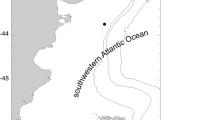Abstract
In this paper, we present evidence of direct development life cycles and brooding behaviour in two narcomedusae species in the family Cuninidae, as well as a histological description of another narcomedusan species from the family Aeginidae. Cunina peregrina were found to be brooding juveniles within the subumbrella. Brood contents varied in size and developmental stage. In addition, pairs of small white spheres enclosed within a membrane, most likely an oocyte and phorocyte (nurse cell) were observed around the stomach wall. It is suggested that two life cycles are occurring simultaneously: (1) asexual budding of actinula larvae from the parent medusa which develop into fully developed medusa; and (2) sexual reproduction producing an egg and phorocyte pair which develops into an actinula and a four-tentacle reduced medusa. In Solmissus incisa opaque spheres of various sizes were attached to the external walls of the gastric pouches. The spheres appeared to start off as a developing oocyte attached firmly to the adult, before developing into a sessile planula larva. The planula had a thick ectoderm and endoderm and was attached to the adult gastric pouches at its oral surface. This attachment appeared to pinch into the adult stomach pouch forcing some stomach tissue into the oral opening of the developing planula, possibly suggesting some nutritional aid from the adult. It is not clear whether this is a parasitism on the adult to gain nutrition or parental brood care. Nine specimens of Aeginura grimaldii were collected. White growths located on the subumbrellar surface in between the gastric pouches were found to be male gonads containing sperm. The gonads had a granular texture consisting of a lightly speckled black pigmentation, which became denser in the red subumbrella tissue. Histology revealed this to be porphyrin bodies.





Similar content being viewed by others
References
Berrill NJ (1950) Development and medusa-bud formation in the hydromedusae. Q Rev Biol 25:292–316. doi:https://doi.org/10.1086/397707
Bigelow HB (1909) Reports on the scientific results of the expedition to the tropical Pacific. XVI: the medusae. Mem Mus Comp Zool Harvard 37:1–243
Bouillon J (1987) Considerations sur le developpment des narcomeduses et sur leur position phylogenetique. Indo-Malay Zool 4:189–278
Bouillon J, Boero F (2000) Phylogeny and classification of hydroidomedusae. The Hydrozoa: a new classification in the light of old knowledge. Thalassia Salentina 24:1–46
Campbell R (1974) Cnidaria. In: Giese A, Pearse J (eds) Reproduction of marine invertebrates. Academic Press, New York, pp 133–199
Gili J-M, Bouillon J, Pages F, Palanques A, Puig P, Heussner S (1998) Origin and biogeography of the deep-water Mediterranean hydromedusae including the description of two new species collected in submarine canyons of northwestern Mediterranean. Sci Mar 62:113–134
Hyman L (1940) The invertebrates: protozoa through ctenophora. McGraw-Hill, New York
Jarms G, Tiemann H, Båmstedt U (2002) Development and biology of Periphylla periphylla (Scyphozoa: Coronatae) in a Norwegian fjord. Mar Biol (Berl) 141:647–657. doi:https://doi.org/10.1007/s00227-002-0858-x
Kramp PL (1961) Synopsis of the medusae of the world. J Mar Biol Assoc UK 40:1–469
Larson RJ, Mills CE, Harbison GR (1989) In situ foraging and feeding behaviour of narcomedusae (Cnidaria: Hydrozoa). J Mar Biol Assoc UK 69:785–794
Larson RJ, Mills CE, Harbison GR (1991) Western Atlantic midwater hydrozoan and scyphozoan medusae: in situ studies using manned submersibles. Hydrobiologia 216/217:311–317. doi:https://doi.org/10.1007/BF00026480
Laval P (1980) Hyperiid amphipods as crustacean parasitoids associated with gelatinous zooplankton. Oceanogr Mar Biol Ann Rev 18:11–56
Lucas CH (2001) Reproduction and life history strategies of the common jellyfish, Aurelia aurita, in relation to its ambient environment. Hydrobiologia 451:229–246. doi:https://doi.org/10.1023/A:1011836326717
Metchnikoff E (1886) On the embryology of medusae and its bearing on the origins of the primary tissues (in Russian). Translation in: Gourko H, Williamson DI, Tauber AI (2000) The evolutionary biology papers of Elias Metchnikoff. Kluwer, Dordrecht
Osborn DA (2000) Cnidarian “parasites” on Solmissus incisa, a narcomedusa. Sci Mar 64:157–163. doi:https://doi.org/10.3989/scimar.2000.64s1157
Pagès F, Corbera J, Lindsay D (2007) Piggybacking pycnogonids and parasitic narcomedusae on Pandea rubra (Anthomedusa: Paneidae). Plankton Benth Res 2:83–90. doi:https://doi.org/10.3800/pbr.2.83
Pitt KA (2000) Life history and settlement preferences of the edible jellyfish, Catostylus mosaicus (Scyphozoa: Rhizostomeae). Mar Biol (Berl) 136:269–279. doi:https://doi.org/10.1007/s002270050685
Raskoff K (2002) Foraging, prey capture and gut contents of the mesopelagic narcomedusa Solmissus sp. (Cnidaria: Hydrozoa). Mar Biol (Berl) 141:1009–1107
Russel FS (1953) The medusae of the British isles vol. I: Anthomedusae, Leptomedusae, Limnomedusae, Trachymedusae and Narcomedusae. Cambridge University Press, London, p 530
Stschelkanowzew J (1906) Die Entwicklung von Cunina proboscidea. Mitteilungen der Zoologischen station in Neapel 17:433–486 (cited in Hyman 1940)
Acknowledgments
Medusa samples were collected during the following cruises: Cape Hatteras, September 1994: NOAA/NURP UNCW9406 awarded to Dr. Tom Bailey, NOAA/NURC UNCW9410 and NSF OCE9313872 awarded to Dr. Tammy Frank and Dr. Edith Widder; Gulf of Maine, June 1995: NOAA/NURC UCAP-95-020A and NSF OCE9313872 awarded to Dr. Tammy Frank and Dr. Edith Widder. CHL would like to thank the above PIs for their help and support during her Harbor Branch Oceanographic Institute Fellowship, and the crew of the RV ‘Edwin Link’ and ‘Johnson-Sea-Link II’ submersible for their assistance during field operations. The authors would also like to thank Prof. Paul Tyler, Dr. Sven Thatje and Dr. Mary Arai for helpful discussions and comments on earlier drafts of this manuscript.
Author information
Authors and Affiliations
Corresponding author
Additional information
Communicated by S.A. Poulet.
Rights and permissions
About this article
Cite this article
Lucas, C.H., Reed, A.J. Observations on the life histories of the narcomedusae Aeginura grimaldii, Cunina peregrina and Solmissus incisa from the western North Atlantic. Mar Biol 156, 373–379 (2009). https://doi.org/10.1007/s00227-008-1089-6
Received:
Accepted:
Published:
Issue Date:
DOI: https://doi.org/10.1007/s00227-008-1089-6




